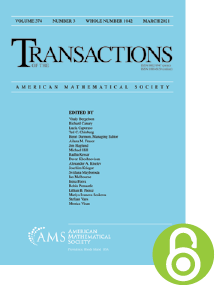Probabilistically nilpotent Hopf algebras
HTML articles powered by AMS MathViewer
- by Miriam Cohen and Sara Westreich PDF
- Trans. Amer. Math. Soc. 368 (2016), 4295-4314 Request permission
Abstract:
In this paper we investigate nilpotenct and probabilistically nilpotent Hopf algebras. We define nilpotency via a descending chain of commutators and give a criterion for nilpotency via a family of central invertible elements. These elements can be obtained from a commutator matrix $A$ which depends only on the Grothendieck ring of $H.$ When $H$ is almost cocommutative we introduce a probabilistic method. We prove that every semisimple quasitriangular Hopf algebra is probabilistically nilpotent. In a sense we thereby answer the title of our paper Are we counting or measuring anything? by Yes, we are.References
- Nicolás Andruskiewitsch, Notes on extensions of Hopf algebras, Canad. J. Math. 48 (1996), no. 1, 3–42. MR 1382474, DOI 10.4153/CJM-1996-001-8
- Alon Amit and Uzi Vishne, Characters and solutions to equations in finite groups, J. Algebra Appl. 10 (2011), no. 4, 675–686. MR 2834108, DOI 10.1142/S0219498811004690
- Sebastian Burciu, Kernels of representations and coideal subalgebras of Hopf algebras, Glasg. Math. J. 54 (2012), no. 1, 107–119. MR 2862388, DOI 10.1017/S0017089511000395
- Miriam Cohen and Sara Westreich, Structure constants related to symmetric Hopf algebras, J. Algebra 324 (2010), no. 11, 3219–3240. MR 2732995, DOI 10.1016/j.jalgebra.2010.07.003
- Miriam Cohen and Sara Westreich, Conjugacy classes, class sums and character tables for Hopf algebras, Comm. Algebra 39 (2011), no. 12, 4618–4633. MR 2863455, DOI 10.1080/00927872.2011.617265
- Miriam Cohen and Sara Westreich, Higman ideals and Verlinde-type formulas for Hopf algebras, Ring and module theory, Trends Math., Birkhäuser/Springer Basel AG, Basel, 2010, pp. 91–114. MR 2744044, DOI 10.1007/978-3-0346-0007-1_{5}
- Miriam Cohen and Sara Westreich, Hit-invariants and commutators for Hopf algebras, Bull. Math. Soc. Sci. Math. Roumanie (N.S.) 56(104) (2013), no. 3, 299–313. MR 3114476
- Miriam Cohen and Sara Westreich, Are we counting or measuring something?, J. Algebra 398 (2014), 111–130. MR 3123755, DOI 10.1016/j.jalgebra.2013.09.015
- Shlomo Gelaki and Dmitri Nikshych, Nilpotent fusion categories, Adv. Math. 217 (2008), no. 3, 1053–1071. MR 2383894, DOI 10.1016/j.aim.2007.08.001
- V. Linchenko and S. Montgomery, A Frobenius-Schur theorem for Hopf algebras, Algebr. Represent. Theory 3 (2000), no. 4, 347–355. Special issue dedicated to Klaus Roggenkamp on the occasion of his 60th birthday. MR 1808131, DOI 10.1023/A:1009949909889
- Hans-Jürgen Schneider, Principal homogeneous spaces for arbitrary Hopf algebras, Israel J. Math. 72 (1990), no. 1-2, 167–195. Hopf algebras. MR 1098988, DOI 10.1007/BF02764619
- Aner Shalev, Word maps, conjugacy classes, and a noncommutative Waring-type theorem, Ann. of Math. (2) 170 (2009), no. 3, 1383–1416. MR 2600876, DOI 10.4007/annals.2009.170.1383
- Mitsuhiro Takeuchi, Quotient spaces for Hopf algebras, Comm. Algebra 22 (1994), no. 7, 2503–2523. MR 1271619, DOI 10.1080/00927879408824973
Additional Information
- Miriam Cohen
- Affiliation: Department of Mathematics, Ben Gurion University of the Negev, Beer Sheva, Israel
- Email: mia@math.bgu.ac.il
- Sara Westreich
- Affiliation: Department of Management, Bar-Ilan University, Ramat-Gan, Israel
- Email: swestric@biu.ac.il
- Received by editor(s): September 25, 2013
- Received by editor(s) in revised form: April 24, 2014
- Published electronically: September 15, 2015
- Additional Notes: This research was supported by the Israel Science Foundation, 170-12.
- © Copyright 2015 American Mathematical Society
- Journal: Trans. Amer. Math. Soc. 368 (2016), 4295-4314
- MSC (2000): Primary 16T05
- DOI: https://doi.org/10.1090/tran/6462
- MathSciNet review: 3453372


